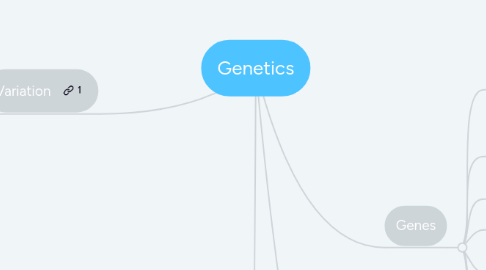
1. Variation
1.1. Inherited
1.1.1. Variation in a characteristic that is a result of genetic information from the parents is called inherited variation.
1.1.2. We get half of our DNA and inherited features from each parent
1.1.3. Here are some examples of inherited variation in humans is seen in eye colour, hair colour, skin colour
1.2. Enviromeantal
1.2.1. Environmental variation are the factors the affects your personality and characteristics
1.2.2. Your characteristics can be affected by factors such as: diet, accidents, culture and lifestyle. For example, you will become heavier if you eat too much food
1.2.3. Your language or religion is in an environmental characteristic
1.3. continuous VS discontinuous
1.3.1. For any species a characteristic that changes over a range of values shows continuous variation. Examples are: Height and Weight
1.3.2. Discontinuous variation is characteristic of any species with only a limited number of possible values. For example: Gender or blood group
2. Conservation
2.1. Extinction
2.1.1. Species becomes extinct when there are no more individuals of that species left. An extinct species has gone forever. This may be caused by new diseases or a new predator
2.1.2. An example of extinction may be The dodo which became extinct in the 17th century because of human activities. Humans brought new predators to the dodo's habitat like dogs.
2.2. Bideiverdity
2.2.1. An endangered species is at risk of becoming extinct. For example, the panda and gorilla are endangered and may become extinct.
2.2.2. A species can become endangered for several reasons, such as the population of the species falling below a critical level
2.2.3. Biodiversity means having as wide a range of different species in an ecosystem as possible
2.2.4. It is important to conserve the variety of living organisms on Earth but conservation maintains the future possibility that plant species might be identified for medicines
3. Genes
3.1. James Watson and Francis Crick used information from an X-ray to work out a model for the structure of DNA
3.2. In a DNA molecule: There are two strands and they are twisted around each other to form a double helix they are held together by bonds between base pairs
3.3. Because it is so long and thin it is coiled into structures called chromosomes
3.4. The red blood cells is the only cell not contain DNA.
3.5. Human body cells each contain 23 pairs of chromosomes
3.6. A gene is a section of DNA that is responsible for a characteristic
3.7. human gametes (egg and sperm) each contain 23 chromosome
3.8. One copy of all your chromosomes is called your genome.
4. Evolution
4.1. Charles darwin was the one to discover evolution we lived from 1809 - 1882
4.1.1. The theory accepted by most scientists is the theory of natural selection by charles darwin
